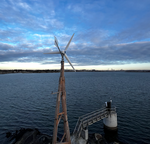04/14/2006
Kenya - Aggreko wins wind energy contract
The Kenian Government has settled on Aggreko International of UK to supply 100 megawatts to cushion Kenyans against rationing. However, the uninterrupted power supply will come at a higher cost to consumers. Consumers are expected to pay an additional Sh1.20 per kilowatt-hour in fuel and other ‘minor’ administrative costs after the Government agreed to subsidise the cost by paying a requisite capacity charge of Sh500 million per month. The chairman of the Emergency Power Committee, Pradeep Paunrana, said under the deal with Aggreko, the Government would finance the rental charges or capacity charge, while the fuel costs charges would be passed on to the end consumer. Officials of Kenya Power and Lighting Company (KPLC) said the full impact of the new emergency power supplies would be noticed by consumers in their September or October bills.
Paunrana said the plant site at KPLC sub-station in Embakassi, Nairobi was under preparation. Paunrana also told a news conference to officially announce the contract yesterday that tenders for the fuel supply during the project 12 months duration have been invited with the proposal expected by today. According to the power project implementation plan, phase one producing 44 megawatts is to be operational by May 13, phase two (80MW) in June and phase three (100MW) by August. "Depending on the performance of the long rains in April to May 2006, the committee will make a decision on whether to install an additional 60MW in Lanet, Nakuru," Paunrana who is also the managing director of Athi River Mining Company said.
Aggreko, the company, which also provided emergency power to Kenya during the 2000 rationing period, beat other firms among them Global Resources, Mantrack and Mag Industries to clinch the lucrative one-year emergency power supply contract. The generators will be used to supplement production of electricity during the drought period, which is expected to reduce hydro energy generation in the country to 7.4 gigawatt hours per day for the period of April 2006 to March 2007.
KenGen managing director, Eddy Njoroge, said despite recent inflows of the current rainwaters into the catchment areas, the company was concerned about the dam levels at the Tana River basin, which holds the main reservoirs for hydroelectric power generation. He said water level at Masinga, the country’s biggest reservoir, has since the beginning of this year been reducing at a worrying rate because of the continued use of water for electricity generation. He said the water level, which has been fluctuating between 1,043.96 metres and 1,044.14 meters early this year is presently at 1,041 meters above the sea level. The dam has a height of 1054 meters above the sea level when full. Energy PS, Patrick Nyoike, said though the cost of power to consumers could go up marginally. "It was little more expensive than no power as currently experienced in many countries of the region, especially in Tanzania and Uganda."
Paunrana said the plant site at KPLC sub-station in Embakassi, Nairobi was under preparation. Paunrana also told a news conference to officially announce the contract yesterday that tenders for the fuel supply during the project 12 months duration have been invited with the proposal expected by today. According to the power project implementation plan, phase one producing 44 megawatts is to be operational by May 13, phase two (80MW) in June and phase three (100MW) by August. "Depending on the performance of the long rains in April to May 2006, the committee will make a decision on whether to install an additional 60MW in Lanet, Nakuru," Paunrana who is also the managing director of Athi River Mining Company said.
Aggreko, the company, which also provided emergency power to Kenya during the 2000 rationing period, beat other firms among them Global Resources, Mantrack and Mag Industries to clinch the lucrative one-year emergency power supply contract. The generators will be used to supplement production of electricity during the drought period, which is expected to reduce hydro energy generation in the country to 7.4 gigawatt hours per day for the period of April 2006 to March 2007.
KenGen managing director, Eddy Njoroge, said despite recent inflows of the current rainwaters into the catchment areas, the company was concerned about the dam levels at the Tana River basin, which holds the main reservoirs for hydroelectric power generation. He said water level at Masinga, the country’s biggest reservoir, has since the beginning of this year been reducing at a worrying rate because of the continued use of water for electricity generation. He said the water level, which has been fluctuating between 1,043.96 metres and 1,044.14 meters early this year is presently at 1,041 meters above the sea level. The dam has a height of 1054 meters above the sea level when full. Energy PS, Patrick Nyoike, said though the cost of power to consumers could go up marginally. "It was little more expensive than no power as currently experienced in many countries of the region, especially in Tanzania and Uganda."
- Source:
- Aggreko International
- Author:
- Edited by Trevor Sievert, Online Editorial Journalist
- Email:
- press@windfair.net
- Keywords:
- wind energy, wind farm, renewable energy, wind power, wind turbine, rotorblade, offshore, onshore

























